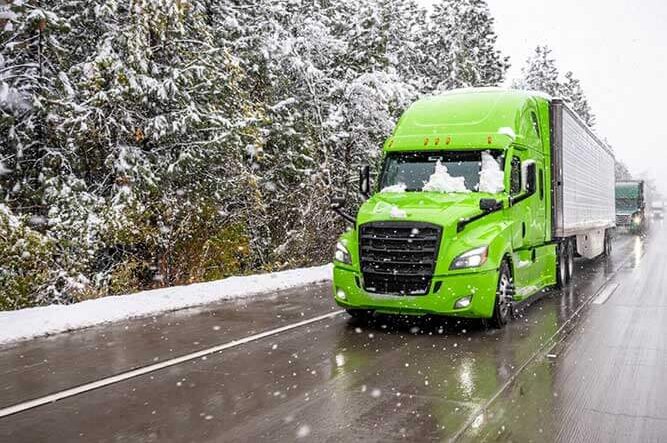Winter Safety: Navigating Chain Laws for Truckers

Find your next load
Make more money starting now.
As the winter chill sets in, truck drivers must consider improving safe driving on ice and snow. Familiarizing yourself with chain laws in each state you travel to is an important first step. Chain laws are regulations that require truck drivers to install chains around their tires during dangerous road conditions such as snow and ice.
Breaking chain laws can result in hefty fines, suspension of CDLs, and life-threatening driving conditions. Laws can vary by state, and it’s vital to understand them for your own safety and to avoid non-compliance.
How Chain Laws Vary by State
During the winter, tire chains help prevent serious accidents—keeping both truck drivers and other drivers on the road around them safe. Losing traction on snow or ice in heavy vehicles, like semi-trucks weighing over 10,000 lbs, can lead to deadly circumstances.
Weather conditions and patterns in each state determine what you’ll need, and when. For example, Colorado, which receives an average of 67 inches of snow every year, has much stricter chain laws than warmer states like Georgia. Nevada, California, Washington, and Oregon all have strict chain laws, including increased fines during the harshest months of the year.
Depending on the state, non-compliance fines range from $50–$500. Getting caught without the required chains in your vehicle can result in a traffic ticket and even place you out of service by the authorities.
Drivers should watch for VMS (variable message signs) on freeways and main roads for chain law alerts. You can also get news about chain law enforcement through state transportation texting systems, transportation radio stations, your electronic logging device, and dispatch.
Tips for Installing Chains Correctly and Safely
Having chains and knowing how to install them is non-negotiable. As soon as inclement weather requires tire chains, pull over in a secure area and begin the process.
Examine your chains
Lay chains out on the road to orient your fasteners facing up (away from the tire), and make sure tensioners are in the open position.
Drape your chains
Drape chains over all four of the outer drive tires. Center each chain so that an equal length hangs over each side of the tire.
Connect them loosely
Make sure to connect chains loosely around each tire. (This is tricky—some drivers use a stick or tool to make it a bit easier). There should be an equal number of chain links on the inside and outside connection.
Drive forward slightly
Once the chains are loosely connected, drive forward a few inches to orient the connectors toward the top of the tire.
Tighten your chains
Tighten the chains so they’re snug but not too tight. Use the tightening tool to crank tensioners as needed. You should still be able to wedge your finger between the chain and the tire.
Remember that tire chains should only be used in the presence of ice or snow—when alerts are active. Using chains on bare or wet pavement can damage the road and your tires.
Preparing your truck for safety in the winter goes beyond chains. Drivers should check their battery’s age, stock the cab with emergency supplies (like blankets and non-perishable food), install an engine block heater if needed, and go over other basic maintenance like working windshield wipers.
How to Deal with a Chain Law Violation
Getting a ticket for violating chain laws is a serious matter for truck drivers. Failing to pay a fine or show up in court on a predetermined date could lead to the suspension of your CDL.
If you’re pulled over for a chain law violation, it’s best to take ownership of the mistake immediately. It’s a driver’s responsibility to be aware of when and where to install chains.
However, if you’ve been stopped for failing to install tire chains and received a violation, you may be able to contest your ticket with a traffic attorney—especially if you feel the ticket was unjust. Find a reputable legal representative in the state where authorities pulled you over and ask for help as soon as possible.
Trust Truckstop For All Your Winter Loads
During this busy time of year, having a trucking technology partner you can trust is so important. Drivers have enough uncertainty around weather conditions in the winter; they shouldn’t have to worry about the legitimacy of their loads, too.
Find more loads and book them faster with real-time updates, rate insights, and Book-it-Now features. Get a demo today for more details.

Find out how our platform gives you the visibility you need to get more done.
Get helpful content delivered to your inbox.
Schedule a demo.
Find out how our platform gives you the visibility you need to get more done.





